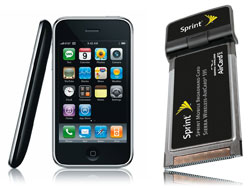It’s Better Than WiFi
Mobile broadband security is better than WiFi because it’s based on cellular technology.
Although its a ‘wireless’ technology like WiFi, no one can scan for your connection in the way you look for a WiFi network.
It’s a private connection that only you have access to whether you’re at home, in Starbucks or at the airport.
Adding to its security is the fact that ready-made hacking tools don’t exist for mobile broadband 3G networks.
James Bond can’t bust into your 3G connection if all he’s got is Microsoft Word. Makes things pretty difficult ya dig?
Naturally, there’s some more robust technical reasoning behind all of this. Before we get into the demystifying mobile broadband from techno-talk to English, let’s recap on a few basics to make sure we’re on the same page.
What is Mobile Broadband?
 Mobile Broadband is any technology that allows someone to access the internet at broadband speeds while on the go (continuously).
Mobile Broadband is any technology that allows someone to access the internet at broadband speeds while on the go (continuously).
Depending on where you go it might be described as wireless broadband.
However, there’s a big difference between the two:
Think of wireless broadband (e.g. WiFi) like a cordless phone. It’s good for around the house.
Mobile broadband, however is like your cell phone. Good just about any and everywhere.
Now here’s another difference that slips by most people:
Mobile broadband security is more tightknit than WiFi for the same reason Apple computers are safer than Windows PCs.
Less people target them.
Naturally, that’s not the only reason of course (reader beware: we’re about to get technical). Right now, (in the United States), there are 2 main ways to get mobile broadband:
1. Evolution Data Optimized (EV-DO)
2. High Speed Packet Access (HSPA)
How Does EVDO Mobile Broadband Security Work?
EVDO runs on CDMA wireless technology authentication and identification system for top-notch mobile broadband security.
The Mobile Identification Number (MIN) and Electronic Serial Number (ESN), together with CDMA spread spectrum technology, make it virtually impossible for unauthorized users to capture and decipher messages and other sensitive information.
Now, I know you probably have a couple questions:
What the heck is a MIN, ESN, CDMA and whatever crazy acronym you wanna throw my way?
No problem. I’ve got you covered.
 The Mobile Identification Number (MIN) is nothing more than the number of a cell phone (or broadband card in this case).
The Mobile Identification Number (MIN) is nothing more than the number of a cell phone (or broadband card in this case).
The Electronic Serial Number (ESN) is another number unique to your device that’s transmitted to a cell phone tower/site along with your MIN (phone number) to verify that you are in fact, you.
As for CDMA (Code Division Multiple Access)?
This is the underlying technology that your broadband speed EVDO runs on.
In addition to the verification of MIN and ESN working together, your data is broken up into small packets that get tagged with codes. Those packets then mix with all other packets in the area to be sent to the cell phone site/tower.
 Here’s an easy way to picture it:
Here’s an easy way to picture it:
It’s like your data gets written in invisible ink and goes through a paper shredder.
Before being transported to the network, it mixes with paper from the whole neighborhood.
When it gets to the network, then they use a dye to pick out your paper before piecing it back together.
It’s like passing encrypted notes in class on a ridiculously high tech level. Even if the teacher (or hacker in our case) found our notes, it wouldn’t even make any sense to them.
This 3 tier level layer of security is the exact reason why EVDO is even more secure than WiFi. While mobile broadband operates in licensed spectrums that you must apply and get authorization from the government, WiFi operates in an unlicensed radio band (2.4 GHz).
A lot of other devices like Bluetooth devices and cordless phones operate in this spectrum. Because of this, it’s harder to ‘police’ that spectrum.
As an added bonus, it’s explicitly illegal for anyone to monitor or ‘listen’ in on cellular transmissions (this includes EVDO and HSPA mobile broadband). It isn’t illegal for someone to just ‘hop’ on an open WiFi network and see what’s going on (in some cases it is, but not all).
How Does HSPA Mobile Broadband Security Work?
HSPA mobile broadband security is rooted in GSM (Global System for Mobile Communications) technology.
While the technology is different from EVDO (based on CDMA), the principles are the same. Each device has a phone number with an electronic serial number that breaks information into little packets.
In other words, it’s safe for pretty much the same reasons.
As Hewlett-Packard puts it:
 "Mobile Broadband has built-in 128-bit encryption, so the risk of data interception, theft, and modification is significantly reduced. This is the same level of encryption used throughout the internet, and for governmental, banking, and military applications. Your data couldn’t be much more secure without being completely inaccessible".
"Mobile Broadband has built-in 128-bit encryption, so the risk of data interception, theft, and modification is significantly reduced. This is the same level of encryption used throughout the internet, and for governmental, banking, and military applications. Your data couldn’t be much more secure without being completely inaccessible".
In Summary
Mobile broadband security keeps data safe because:
- It utilizes a mobile phone number (a fingerprint of sorts)
- It uses an Electronic Serial Number (a second fingerprint)
- The information is scrambled and mixed with other unrelated information in the area
- It operates within licensed spectrum
- It’s the same level of encryption used for government, banking and military applications
- It’s much more difficult to eavesdrop on (no WiFi network for people to ‘snoop out’)
Were security issues the only thing stopping you from getting mobile broadband?
If that’s the case, here’s where you can:
Get a Free Broadband Card & Start Browsing Safely With Mobile Broadband Security
If you decide to get mobile broadband through one of the links below, I do make some money. Just some full disclosure. Besides, every broadband card is free or puts money in your pocket. Talk about win-win.



Yaakov says:
Do you have information/recommendation for using mobile broadband out of US, specifically Israel for connection for 40 hours/week.